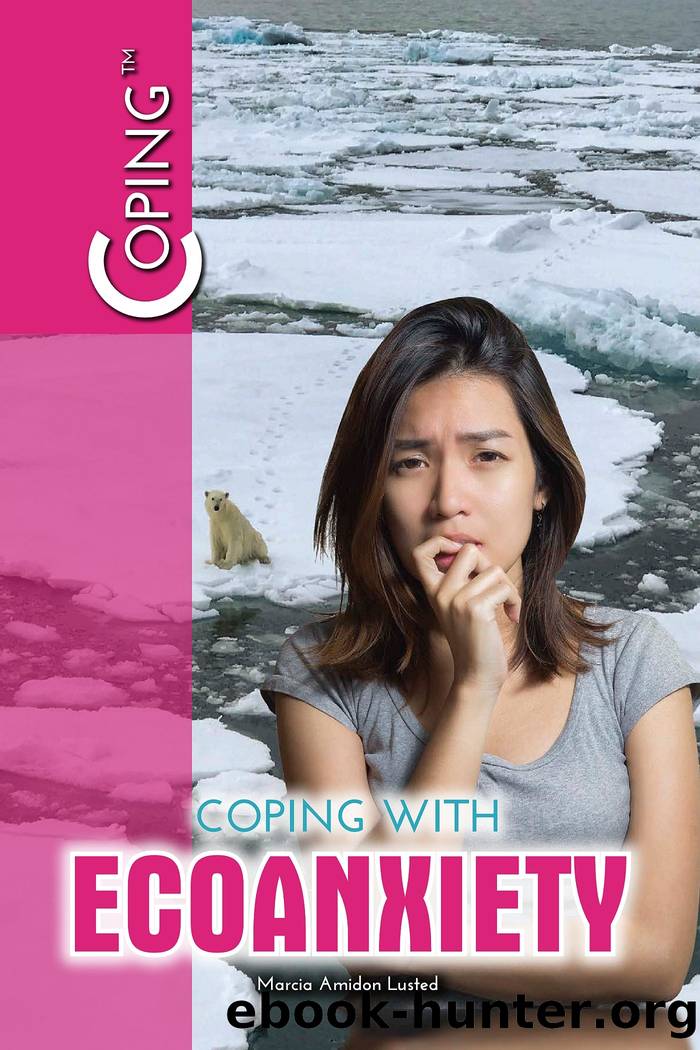Coping with Ecoanxiety by Marcia Amidon Lusted

Author:Marcia Amidon Lusted [Lusted, Marcia Amidon]
Language: eng
Format: epub
Publisher: The Rosen Publishing Group, Inc
Published: 2018-12-27T00:00:00+00:00
Ecoanxiety is especially common with millennials, as they grew up watching negative media reports on the environment. The Harris Poll, which was featured in an April 2018 PRNewswire.com article, lists the following:
⢠92% of Americans are worried about the future of our planet
⢠Nearly three quarters (72%) of millennials 18â34 say that watching, hearing and/or reading negative news stories about the environment sometimes has an impact on their emotional wellbeing (e.g., anxiety, racing thoughts, sleep problems, a feeling of uneasiness)
⢠Among those who say they are worried about the future of our planet, about two-thirds say they take steps to reduce energy use in their home (68%) or take steps to reduce water waste in their home (64%)
⢠Only 13% of American adults invest in environmentally responsible companies to address worries about the future of the planet, but millennials are ahead of the curve with 20% investing in companies that prioritize the environment.
Progressive Stages of Ecoanxiety
Ecoanxiety develops in progressive stages. In the first stage, denial, people avoid any acknowledging that a problem exists. Then, as people become more consciously aware of the issue, they move on to Stage 2, semi-consciousness. Stage 3 is described as a moment of realization. Such a moment might occur when reading a compelling article or when personally experiencing the negative impacts of climate change, such as a natural disaster. Once people âwake upâ to the threats that Earth is facing and reach a so-called âpoint of no return,â also known as Stage 4, they typically experience feelings of despair, hopelessness, and guilt in Stage 5. This is followed by the final stage of acceptance and action, in which people take steps to help the environment and live a more sustainable lifestyle.
Itâs during Stage 4 that ecoanxiety can, like other anxiety disorders, manifest itself with both mental and physical symptoms. Most of these symptoms are similar to general anxiety disorders, including panic attacks, insomnia, nightmares, grief, helplessness, depression, and irritability. Those with ecoanxiety may burst into tears when they see news items about extinct animals or melting ice sheets. Physical symptoms may include physical pain, unexplained weakness, and loss of appetite. In extreme cases, ecoanxiety sufferers may even feel rage.
Eco Extreme: Ecoterrorism
Download
This site does not store any files on its server. We only index and link to content provided by other sites. Please contact the content providers to delete copyright contents if any and email us, we'll remove relevant links or contents immediately.
Harry Potter: A Journey Through a History of Magic by British Library(368)
The Science of Philip Pullman's His Dark Materials by Mary Gribbin(343)
The Basics of Organic Chemistry by Clowes Martin;(342)
Harry Potter and the Sorcerer's Stone: SparkNotes Literature Guide by SparkNotes(305)
Flowers in the Gutter by K. R. Gaddy(272)
Braiding Sweetgrass for Young Adults by Robin Wall Kimmerer(266)
Super Simple Chemistry by D.K. Publishing(262)
Summary of the Selfish Gene by Readtrepreneur Publishing(259)
Exam Success in Geography for IGCSE & O Level by Unknown(258)
JavaScript Coding for Teens: A Beginner's Guide to Developing Websites and Games by Yueh Andrew(251)
Dark days in Salem: the witchcraft trials by Deborah Kent(244)
The Python Audio Cookbook;Recipes for Audio Scripting with Python by Alexandros Drymonitis(240)
Analysis and Linear Algebra for Finance: Part II by Bookboon.com(236)
Key Immigration Laws by Kathryn Ohnaka(229)
Cracking the AP Economics Macro & Micro Exams, 2017 Edition by Princeton Review(225)
Solutions for a Cleaner, Greener Planet: Environmental Chemistry by Marc Zimmer(216)
The Science of Fashion by Julie Danneberg;(212)
Reverse Engineering For Everyone! by mytechnotalent(203)
Cracking the AP Psychology Exam, 2017 Edition by Princeton Review(199)
